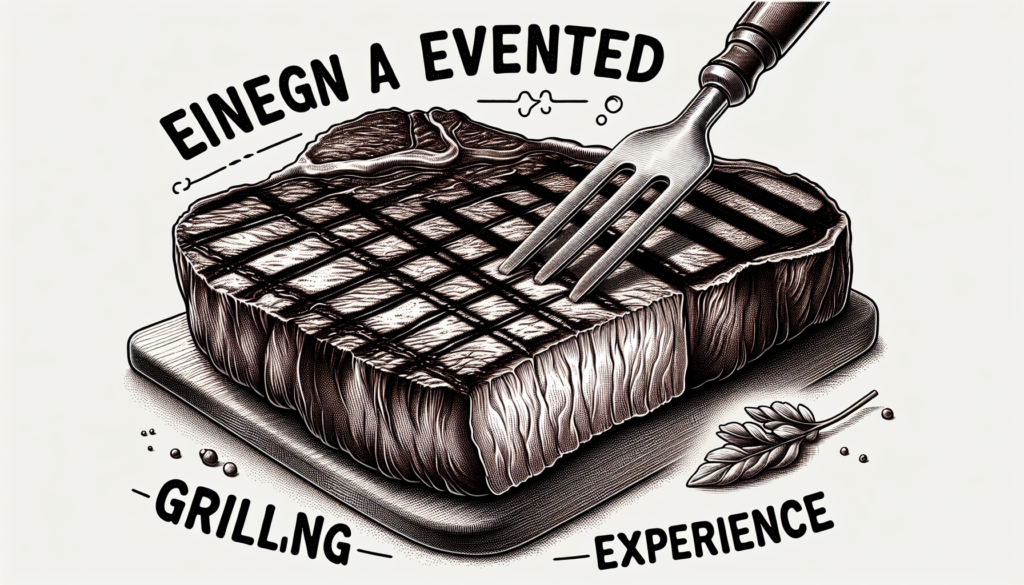Are you tired of overcooking or undercooking your steaks on the grill? Look no further because we have the solution for you – reverse searing. In this article, we will guide you through the process of perfecting reverse seared steaks on the grill, ensuring that every bite is tender, juicy, and full of flavor. Say goodbye to those disappointing grilling experiences and get ready to impress your friends and family with restaurant-quality steaks cooked to perfection right in your own backyard. So, let’s fire up the grill and get started on your journey to steak perfection!

Choosing the Right Cut of Steak
When it comes to grilling the perfect steak, one of the most important factors to consider is the cut of meat you choose. Different cuts of steak offer different flavors, tenderness, and marbling. The first thing to consider is the thickness of the steak. Thicker steaks are ideal for reverse searing because they provide a larger margin for error when it comes to cooking temperatures.
Another consideration is whether to opt for bone-in or boneless steaks. Bone-in steaks, such as ribeye or T-bone, add extra flavor and juiciness to the meat. On the other hand, boneless steaks, like filet mignon or New York strip, offer a more consistent texture throughout the cut. Ultimately, the choice between bone-in or boneless comes down to personal preference and the desired eating experience.
Lastly, selecting the best grade of meat is essential for a delicious steak. The grade of meat refers to its level of marbling and overall quality. Prime grade is the top-tier choice, with abundant marbling that results in a buttery and flavorful steak. Choice grade meat is also a good option, offering a balance of marbling and tenderness. Select grade meat, while leaner, may require additional care to prevent the meat from drying out during the cooking process.
Preparing the Steak
Before you start grilling, there are a few important steps in preparing the steak to ensure optimal flavor and texture. First, seasoning the meat is crucial to enhancing its natural flavors. A simple combination of kosher salt and freshly ground black pepper is often sufficient, but you can also experiment with various seasonings and rubs to suit your taste preferences.
Bringing the steak to room temperature is another crucial step. Allowing the meat to sit at room temperature for about 30 minutes before grilling ensures more even cooking throughout the steak. This is especially important if you’re cooking thicker cuts, as it helps prevent the steak from being too cold in the center.
Another important step is patting the steak dry before grilling. Moisture on the surface of the steak can interfere with achieving a perfect sear. Use a paper towel to gently remove excess moisture from the steak’s surface. This step also helps the seasonings adhere better to the meat, resulting in a more flavorful crust.
Setting up the Grill
To achieve the perfect reverse seared steak, setting up the grill properly is crucial. First, choosing the right fuel is important for achieving the desired flavors and cooking temperatures. Charcoal provides a smoky flavor, while gas grills offer convenience and precise temperature control. Ultimately, the choice between the two comes down to personal preference and the level of control you want over the cooking process.
Before placing the steak on the grill, it’s essential to preheat the grill to the desired cooking temperature. Preheating ensures that the grill grates are evenly heated and ready to sear the steak. For reverse searing, a two-zone fire setup is recommended. This means having one side of the grill with direct high heat and the other side with indirect low heat.
Indirect Heat Cooking
Once the grill is set up and preheated, it’s time to start cooking the steak using indirect heat. Place the steak on the cooler side of the grill, away from the direct heat source. This allows the steak to slowly cook to the desired internal temperature without burning the exterior.
Using a probe thermometer is crucial for monitoring the internal temperature of the steak. Insert the probe into the thickest part of the steak, away from any bones. This ensures an accurate reading of the meat’s temperature. Aim for a low and slow cooking temperature, around 225°F to 250°F, to gradually bring the steak to the desired doneness.
Maintaining a consistent cooking temperature is important to achieve even cooking throughout the steak. Keep an eye on the grill’s temperature and make adjustments as needed. This may involve adding more fuel or adjusting the vents to regulate airflow and maintain the desired temperature.

Sealing the Steak
After the steak has reached the desired internal temperature using indirect heat, it’s time to move it to the hotter side of the grill to achieve a perfect sear. Searing the steak on high heat creates a flavorful crust that locks in the juices and adds a caramelized char.
Carefully transfer the steak to the hotter side of the grill using tongs or a spatula. Allow the steak to sear for a couple of minutes on each side, rotating it to ensure even browning. The high heat creates a Maillard reaction, resulting in a delicious crust on the exterior of the steak.
Achieving a perfect crust requires patience and attentiveness. Keep a close eye on the steak as it sears, adjusting the heat if necessary to prevent burning. The goal is to develop a rich brown crust while maintaining a tender and juicy interior.
Resting and Carving
Once the steak is seared to perfection, it’s important to let it rest before carving and serving. Allowing the steak to rest for about five to ten minutes allows the juices to redistribute throughout the meat, resulting in a more tender and flavorful steak.
Cover the steak loosely with foil during the resting period to retain its heat and prevent excessive moisture loss. This short resting period gives you time to prepare any accompanying sides or sauces.
When it’s time to carve the steak, make sure to slice against the grain. This ensures tender and easy-to-chew slices. Use a sharp knife and start by cutting the steak into thick slices. Serve the steak with its delicious crust facing up to showcase your grilling skills.
Experimenting with Flavors
While a perfectly cooked steak is delicious on its own, you can take it to the next level by experimenting with different flavors and accompaniments. Marinades and dry rubs are great ways to add depth and complexity to the steak’s flavor profile. Try marinating the steak in a mixture of herbs, spices, and acid-based liquids like vinegar or citrus juice for several hours before grilling.
Infusing your steak with wood smoke adds an extra layer of smoky flavor. Use hardwood chips or chunks, such as hickory, mesquite, or cherry, to impart a unique aroma. Soak the wood in water for at least 30 minutes before placing them on the coals or in a smoker box.
Pairing your grilled steak with fruit and vegetable sides adds freshness and balance to the meal. Grilled asparagus, roasted garlic mashed potatoes, or a crisp summer salad can complement the rich flavors of the steak. Get creative and experiment with different combinations to find your perfect steak dinner.
Achieving the Desired Doneness
Ensuring your steak is cooked to the desired doneness is crucial for a satisfying eating experience. An instant-read thermometer is a reliable tool for accurately measuring the internal temperature of the steak. Insert the thermometer into the thickest part of the steak to get an accurate reading.
Different doneness levels have distinct temperature ranges to aim for. For rare, the internal temperature should be around 125°F to 130°F. Medium-rare is achieved at 135°F to 140°F, and medium is around 145°F to 150°F. Well-done steaks reach an internal temperature of 160°F and above.
In addition to using a thermometer, testing the steak’s firmness can also give you an indication of its doneness. Gently press the center of the steak with your finger. A rare steak will feel soft and springy, while a well-done steak will feel firm. With experience, you’ll be able to gauge the doneness based on the feel of the steak.
Accompaniments and Wine Pairings
Choosing the right side dishes and sauces can elevate the flavors of your grilled steak. Classic accompaniments like roasted potatoes, grilled vegetables, or creamy mashed cauliflower can complement the richness of the steak. Consider incorporating contrasting flavors and textures to create a well-rounded meal.
Sauces are another way to enhance the flavors of your steak. A classic peppercorn sauce, a tangy chimichurri, or a rich mushroom sauce can add depth and complexity to each bite. Experiment with your favorite flavors to find the perfect sauce for your grilled steak.
Pairing your steak with the right wine can further enhance the dining experience. For red meat like steak, bold red wines such as Cabernet Sauvignon, Malbec, or Syrah are excellent choices. The tannins in these wines complement the richness of the steak, while the fruity and earthy notes provide a pleasant contrast.
Tips and Troubleshooting
Grilling the perfect steak requires practice and attention to detail. Here are some tips to help you avoid common mistakes and troubleshoot any issues that may arise.
- Avoid flipping the steak too frequently. Allow it to develop a good sear before turning it over.
- Use a meat thermometer to ensure accurate and consistent cooking temperatures.
- Adjust cooking times for thicker steaks by increasing the time on the indirect heat side.
- Keep a close eye on the grill and meat temperature, making adjustments as needed to maintain the desired cooking environment.
- Let the steak rest before slicing to ensure a juicier and more flavorful end result.
By following these tips and techniques, you’ll be well on your way to grilling the perfect reverse seared steak. Experiment with flavors, practice your grilling skills, and enjoy the delicious rewards of a well-cooked steak. Happy grilling!
